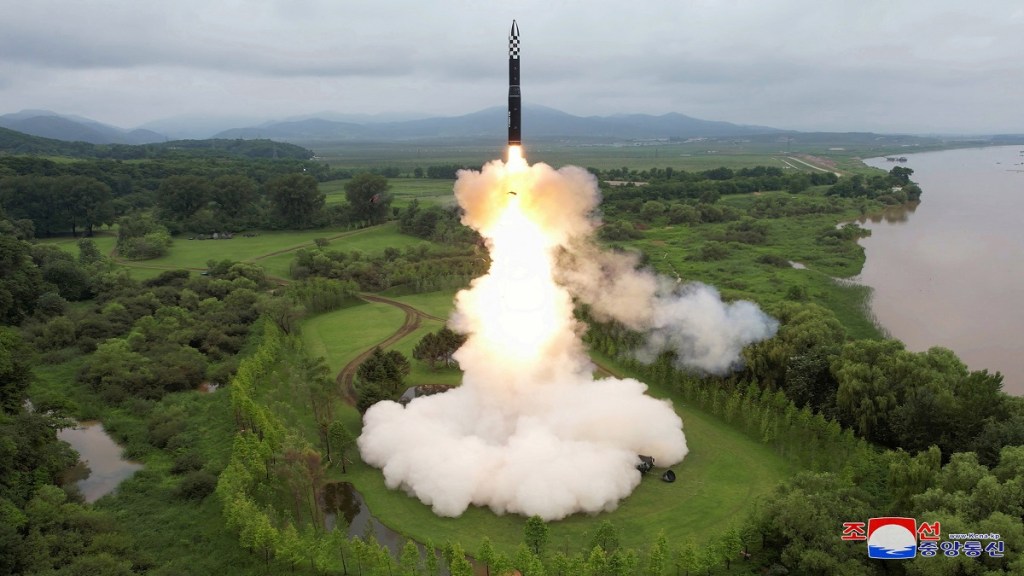North Korea fired two ballistic missiles eastwards early on Wednesday, the Japanese and South Korean militaries said, just hours after a U.S. ballistic missile submarine arrived in a South Korean port for the first time in four decades.
South Korea has issued a warning over the firing of ballistic missiles, with the military at full alert in the Korean peninsula. Both of the missiles appeared to have fallen outside Japan’s exclusive economic zone, the Japanese Defence Ministry said.
The USS Kentucky, an Ohio class nuclear-armed ballistic missile submarine (SSBN), made port in the southeastern city of Busan in South Korea. As per the reports, the arrival of the SSBN coincided with the start of talks among the allies as they gather to discuss and coordinate the responses in the event of a nuclear war with North Korea.
South Korean President Yoon Suk Yeol, aboard the submarine, said its arrival highlighted the alliance’s resolve to deploy U.S. strategic assets and improve its capabilities.
“We will make it impossible for North Korea to ever think of a nuclear provocation, and have clearly warned that if it does, it will lead to the end of its regime,” Yoon said in a speech.
Both of the missiles fired by North Korea appeared to have fallen outside Japan’s exclusive economic zone, the Japanese Defence Ministry said.
South Korea’s Joint Chiefs of Staff (JCS) called on the North to cease such launches.
“We strongly condemn North Korea’s successive ballistic missile launches as grave provocative acts that undermine the peace and stability of the Korean Peninsula as well as the international community, and are a clear violation of U.N. Security Council resolutions,” the JCS said in a statement.
The U.S. military said it was aware of the missile launches and was consulting closely with its allies and partners.
While the launches do not appear to pose an immediate threat to the US or to its allies, the events point out the continuing build-up of North Korea’s weapons programme.
North Korea’s new missiles and nuclear arsenal
In fact, the firing comes only a week after North Korea tested its latest Hwasong-18 intercontinental ballistic missile. The North Korean regime announced the launch as a warning to the US and its allies.
North Korea has been testing ballistic and cruise missiles, including hypersonic missiles, which are capable of being detected by radar due to their low-flying trajectory. The tests also include ballistic missiles fired from submarine.
In fact, in the last year, North Korea tested a record number of nuclear-capable missiles and threatened the preemptive use of nuclear weapons with long-range capabilities targeting US territory.
North Korea’s Hwasong-18 missile which was launched and ‘tested’ this year is among the most sophisticated missiles in its calls which is based on solid fuel. According to a military report, the Hwasong-18’s reach may exceed 15000 Km.
While North Korea’s missile programme is progressing at full speed, its nuclear capability remains largely stalled after it tested a nuclear bomb of an estimated 100-200 Kiliton in 2017.
However, in the latest report, the UN nuclear watchdog agency, International Atomic Energy Agency (IAEA) talks about the revival of the North Korean nuclear weapon program. North Korea seems to have started the reactor which makes its weapons-grade plutonium, it says.
In September 2022, IAEA chief Rafael Grossi further warned the international community there were signs that a test site at Punggye-ri was open again. While the IAEA has not had access to North Korean nuclear facilities since the regime forced out IAEA inspectors out of the country in 2009, it uses satellite imagery and source-based information to monitor North Korea’s nuclear programme.
Soon after the test, Japanese Defence Minister Yasukazu Hamada held a press conference where he elaborated on the range of missiles.
“The first missile reached an altitude of 50 km (31 miles) and covered a range of 550 km, while the second one rose as high as 50 km and flew 600 km,” he said.
Also on Tuesday, a U.S. soldier facing disciplinary action fled across the inter-Korean border into North Korea. The soldier is believed to be in North Korean custody, Washington said, creating a new crisis between the two foes.
“North Korea’s latest firing of ballistic missiles is probably unrelated to an American soldier crossing the inter-Korean border, but such an incident doesn’t help matters either,” said Leif-Eric Easley, a professor at Ewha University in Seoul.
North Korea “undoubtedly opposes” a new U.S.-South Korea nuclear war planning group that met for the first time on Tuesday, as well as the visit of the U.S. nuclear ballistic missile submarine, he said.

